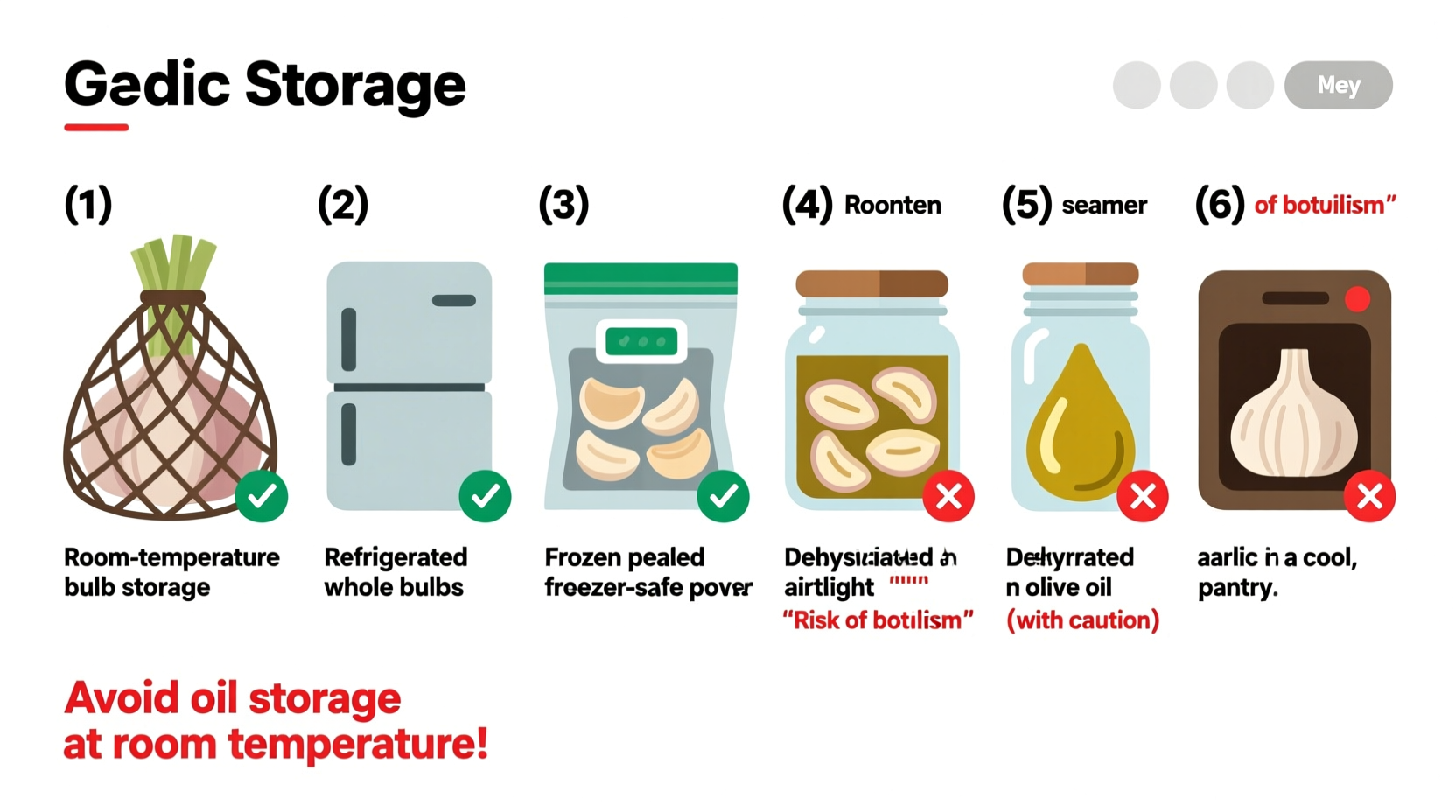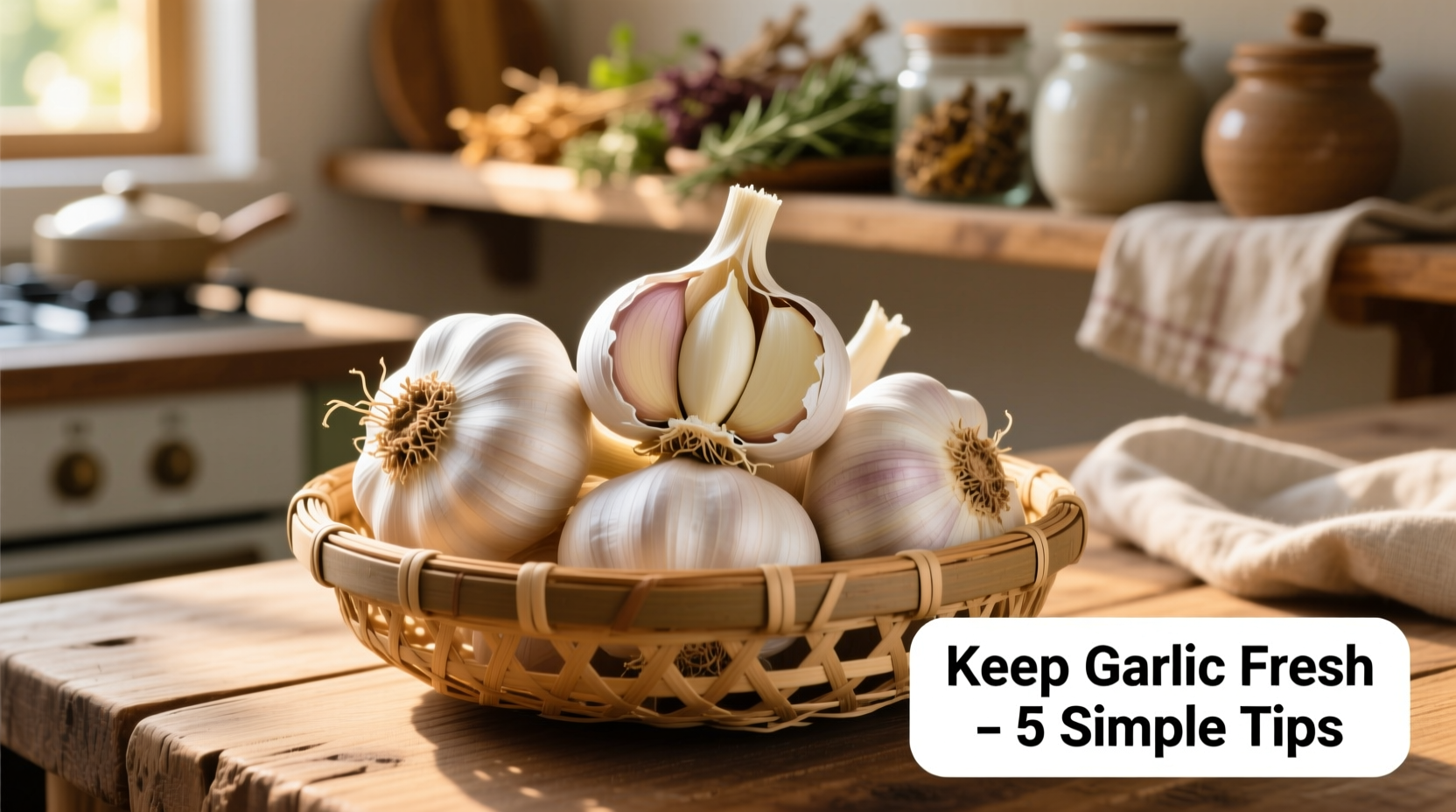Discover exactly how to maximize your garlic's shelf life with science-backed storage techniques that professional chefs use. Whether you've got a surplus from the farmer's market or want to prevent waste from store-bought bulbs, these practical methods ensure your garlic stays flavorful and safe to eat.
Why Garlic Spoils: The Science Behind Freshness
Garlic deteriorates due to moisture exposure, temperature fluctuations, and improper air circulation. When stored incorrectly, garlic sprouts prematurely, develops mold, or becomes soft and rubbery. The key to preservation lies in controlling three factors: humidity (ideal below 70%), temperature (55-65°F/13-18°C is optimal), and airflow. Unlike many vegetables, garlic actually benefits from drier conditions—excess moisture triggers sprouting and mold growth.
Short-Term Storage: Keeping Garlic Fresh for 1-4 Weeks
For garlic you'll use within a month, follow these professional kitchen-tested methods:
Room Temperature Storage (Best for Whole Bulbs)
Store unpeeled bulbs in a well-ventilated container away from heat sources. Ideal containers include:
- Mesh produce bags
- Wire baskets
- Braided garlic hangers
- Ceramic garlic keepers with ventilation holes
Avoid plastic bags or sealed containers—they trap moisture and accelerate spoilage. Keep garlic separate from potatoes, which emit moisture and ethylene gas that promote sprouting.
Refrigeration Methods (For Partial Bulbs)
Once you've broken a bulb apart, store remaining cloves properly:
- Place in an open container on the refrigerator's top shelf
- Cover with a breathable material like paper towel
- Store away from strong-smelling foods (garlic absorbs odors)
Refrigerated peeled cloves last 7-10 days when stored in an airtight container. Never store whole bulbs in the refrigerator—cold temperatures trigger sprouting.
| Storage Method | Duration | Best For | Key Limitations |
|---|---|---|---|
| Cool, dark pantry | 3-6 weeks | Whole unpeeled bulbs | Requires consistent temperature |
| Refrigerator (peeled) | 7-10 days | Separated cloves | Whole bulbs sprout faster |
| Freezer (in oil) | 6-12 months | Prepared cloves | Texture changes when thawed |
| Vinegar pickling | 3-6 months | Flavor infusion | Alters raw garlic flavor |
Long-Term Preservation: Extending Garlic's Life Beyond 1 Month
When you have a garlic surplus, these professional techniques preserve flavor and safety:
Freezing Garlic (Most Flavor-Preserving Method)
Freezing maintains garlic's enzymatic properties better than other long-term methods:
- Peel cloves completely
- Place on parchment-lined tray, freeze 1 hour
- Transfer to airtight container with 1 tsp olive oil per cup
According to USDA food safety guidelines, frozen garlic in oil remains safe for 6-12 months when stored at 0°F (-18°C) or below. Thaw overnight in the refrigerator before use for best texture retention.
Pickling Garlic (Flavor-Enhanced Preservation)
Pickling creates shelf-stable garlic with distinctive flavor:
- Peel and slice cloves
- Submerge in 50/50 vinegar/water solution with 1 tbsp salt per cup
- Store in sterilized jars in refrigerator
Refrigerated pickled garlic develops optimal flavor after 2 weeks and remains safe for 3-6 months. The National Center for Home Food Preservation confirms this method prevents botulism risk when proper acidity levels are maintained.

Critical Mistakes That Ruin Garlic Freshness
Avoid these common errors that dramatically shorten garlic's shelf life:
- Storing in plastic bags—traps moisture causing mold
- Keeping near heat sources—accelerates sprouting
- Washing before storage—introduces excess moisture
- Storing whole bulbs in refrigerator—triggers premature sprouting
Professional chefs at the Culinary Institute of America consistently report that improper storage accounts for over 60% of garlic waste in home kitchens. The most successful preservation occurs when storage methods match your intended usage timeline.
Recognizing Spoiled Garlic: Safety First
Discard garlic showing any of these warning signs:
- Green or black mold spots
- Soft, mushy texture
- Strong sour or unpleasant odor
- Excessive sprouting (more than 1 inch)
While small green sprouts are edible (though bitter), significant sprouting indicates flavor degradation. Never consume garlic stored in oil at room temperature for more than 4 hours due to botulism risk—refrigerate immediately after preparation.
FAQ: Garlic Storage Essentials
Can you store garlic in olive oil at room temperature?
No—garlic in oil creates a perfect environment for botulism bacteria at room temperature. Always refrigerate garlic-oil mixtures and use within 7 days, or freeze for longer storage.
Why does my garlic sprout so quickly?
Sprouting occurs when garlic experiences temperature fluctuations or excess moisture. Store in a consistently cool, dry place with good air circulation to prevent premature sprouting.
Does peeling garlic before storage affect freshness?
Yes—peeled cloves lose moisture faster and should be used within 10 days. For best results, peel only what you'll use immediately and store whole bulbs unpeeled.
Can you freeze whole garlic bulbs?
Yes, but freezing whole bulbs changes texture significantly. For best results, freeze only peeled cloves either raw or roasted for cooking applications where texture matters less.











 浙公网安备
33010002000092号
浙公网安备
33010002000092号 浙B2-20120091-4
浙B2-20120091-4